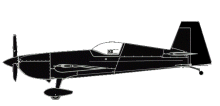
ASN Wikibase Occurrence # 308537
This information is added by users of ASN. Neither ASN nor the Flight Safety Foundation are responsible for the completeness or correctness of this information.
If you feel this information is incomplete or incorrect, you can submit corrected information.
| Date: | Wednesday 13 January 2021 |
| Time: | 14:19 LT |
| Type: |  Extra EA-300/L |
| Owner/operator: | Private |
| Registration: | N771JP |
| MSN: | 054 |
| Year of manufacture: | 1997 |
| Total airframe hrs: | 1008 hours |
| Engine model: | Lycoming AEIO-540 SER |
| Fatalities: | Fatalities: 0 / Occupants: 1 |
| Aircraft damage: | Substantial |
| Category: | Accident |
| Location: | Pell City, Alabama -
 United States of America United States of America
|
| Phase: | Approach |
| Nature: | Private |
| Departure airport: | Gadsden-Northeast Alabama Regional Airport, AL (GAD/KGAD) |
| Pell City-St. Clair County Airport, AL (PLR/KPLR) | |
| Investigating agency: | NTSB |
| Confidence Rating: |
The pilot departed on a short local flight with 14 gallons of fuel in the main wing tanks and 12 gallons in the center tank. About 1,500 ft above ground level, the airplane experienced a total loss of engine power. The pilot initially attempted to restart the engine using fuel from the center tank in accordance with the Extra 300L Pilot's Operating Handbook, which stated that engine restart in flight should be attempted on the center fuel tank. However, when the engine did not restart, he switched back to the main tanks but was still unable to restart the engine. The pilot made a forced landing, during which the airplane sustained substantial damage.
A detailed examination of the engine revealed no anomalies. The engine was rotated manually, and thumb compression was obtained on all cylinders. A small amount of fuel was found at the inlet of the engine-driven fuel pump and the inlet to the fuel servo. The fuel inlet screen was removed from the fuel injector and found to be clean and unobstructed. About two to three drops of fuel were found in the line connecting the fuel injector to the fuel flow gauge. About two to three drops of fuel were also found in the line from the fuel flow gauge to the fuel manifold. After fuel was added to the center tank, the engine started and ran smoothly and continuously.
The pilot stated that, before takeoff, he checked the fuel quantity in the left fuel tank but not the right fuel tank.
The higher quantity of fuel toward the fuel pump compared with the quantity leading to the fuel manifold suggested that the lines were empty of fuel before the pilot switched to the center tank fuel supply, partially allowing some fuel back into the system but not enough to reach the combustion chambers before the pilot switched back to the main tanks. Thus, if the pilot had continued the restart procedure using the center fuel tank, as stated in the Pilots' Operating Handbook, the engine would likely have regained power. Instead, fuel starvation occurred.
The pilot provided information indicating that the accident could have been the result of the Extra EA300L fuel pickup tubes being rotated upward during maintenance, which would have prevented usable fuel from entering the fuel line. However, only trace amounts of fuel were found in the wing, and no maintenance records were provided to indicate when the fuel pickup tubes could have been incorrectly positioned.
Probable Cause: The pilot's mismanagement of the fuel supply, which resulted in fuel starvation. Contributing to the accident was the pilot's failure to follow the manufacturer's engine restart procedures after a total loss of engine power and his incomplete preflight inspection.
Accident investigation:
 |
|
Sources:
NTSB ERA21LA107
Location
Revision history:
| Date/time | Contributor | Updates |
|---|
Corrections or additions? ... Edit this accident description
The Aviation Safety Network is an exclusive service provided by:


 ©2024 Flight Safety Foundation
©2024 Flight Safety Foundation